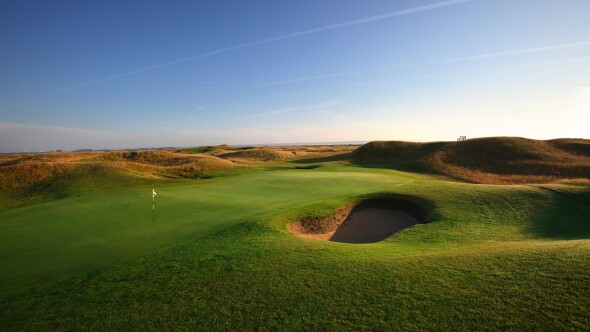The Royal St. Georges Golf Club

About
Only three courses - the Old Course at St. Andrews, Prestwick and Muirfield - have held more Opens than Royal St. George’s, the links laid upon Pegwell Bay in 1887 that will host its 15th Open in 2021. Notable winners at Royal St. George's include Harry Vardon (1899, 1911), Walter Hagen (1922, 1928), Greg Norman (1993) and Darren Clarke (2011). The course winds in all directions through challenging linksland in southeast England. The largest of the dunes surround holes 4-6. The back nine is generally considered the tougher loop where many contenders have fallen by the wayside. Overseas visitors are welcome Mondays through Fridays, but there are certain restrictions. Contact the club for details.
| Tee | Par | Length | Rating | Slope |
|---|---|---|---|---|
| Championship | 70 | 7204 yards | 75.2 | 138 |
| Medal (W) | 74 | 6630 yards | 78.8 | 146 |
| Medal | 70 | 6630 yards | 72.5 | 133 |
| Weekday | 70 | 6340 yards | 71.0 | 129 |
| Weekday (W) | 74 | 6340 yards | 77.2 | 140 |
| Pinto | 70 | 5801 yards | 68.3 | 115 |
| Pinto (W) | 74 | 5801 yards | 74.6 | 134 |
| Hole | 1 | 2 | 3 | 4 | 5 | 6 | 7 | 8 | 9 | Out | 10 | 11 | 12 | 13 | 14 | 15 | 16 | 17 | 18 | In | Total |
|---|---|---|---|---|---|---|---|---|---|---|---|---|---|---|---|---|---|---|---|---|---|
| Championship M: 76.4/150 | 442 | 426 | 239 | 496 | 416 | 176 | 573 | 457 | 410 | 3635 | 412 | 242 | 379 | 457 | 545 | 493 | 161 | 424 | 456 | 3569 | 7204 |
| Medal M: 73.9/143 W: 80.8/155 | 411 | 385 | 195 | 415 | 416 | 152 | 490 | 419 | 373 | 3256 | 371 | 215 | 361 | 442 | 533 | 436 | 161 | 418 | 437 | 3374 | 6630 |
| Weekday M: 72.3/136 W: 79.1/153 | 399 | 350 | 180 | 412 | 406 | 142 | 464 | 395 | 366 | 3114 | 351 | 202 | 340 | 420 | 507 | 435 | 150 | 392 | 429 | 3226 | 6340 |
| Pinto M: 69.9/129 W: 76.1/146 | 381 | 325 | 154 | 305 | 368 | 140 | 407 | 356 | 314 | 2750 | 330 | 182 | 323 | 398 | 487 | 397 | 149 | 390 | 395 | 3051 | 5801 |
| Handicap | 10 | 6 | 16 | 2 | 8 | 18 | 14 | 4 | 12 | 9 | 7 | 15 | 3 | 13 | 1 | 17 | 5 | 11 | |||
| Par | 4 | 4 | 3 | 4 | 4 | 3 | 5 | 4 | 4 | 35 | 4 | 3 | 4 | 4 | 5 | 4 | 3 | 4 | 4 | 35 | 70 |
Course Details
Rentals/Services
Practice/Instruction
Policies
Food & Beverage
SnacksAvailable Facilities
ClubhouseReviews
A championship walk
This review is a recollection of my day playing Royal St. George's in 2014. RSG is the kind of links you jump through hoops to play, and that's exactly what I did. I abandoned my wife and two kids in London by hopping a two-hour train ride to Kent to play 36 holes on Royal St. George's and Deal.
The forecast was a drenching rain all day. Somehow, I escaped both rounds without needing waterproofs. I played with the club secretary, who pointed out all the places where historic shots had been played through the years.
My lasting impression is Royal St. George's demanding shot-making. Although there's really only one section of big dunes, holes 4-6, every hole had uneven, wavy fairways; deep revetted bunkers and tricky angles to navigate. It keeps your game off balance and on the defensive. It's not a glamorous links with grand views or an inspiring landscape. Shot for shot, though, there's few better.
I didn't get to spend any time in the clubhouse or enjoy its jacket-and-tie lunch that's well-known throughout the UK. That experience remains on my bucket list.




























